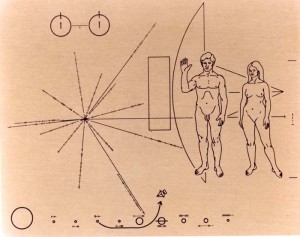The Pioneer 10 spacecraft was launched to explore the farthest edges of our galactic neighborhood. It was aimed at a distant galaxy, and it contained a golden plaque designed to introduce humanity to extra-terrestrial life forms. Believe it or not, this ambitious project is a useful model for documenting your Six Sigma improvements.
Space Aliens and Six Sigma
When project teams reach the control phase of Six Sigma, they face the same communication challenges as the scientists who engraved the plaque on Pioneer 10. How do you convey a message to someone, or something, who doesn’t share the same points of reference?
Decades of science fiction movies have taught us that the quality of our communication between humans and space aliens sets the tone for the success of the relationship. When the communication is open and effective, the experience can be warm and rewarding as in E.T. The Extra-Terrestrial. When communication is an incomprehensible code that we don’t understand, it leaves us puzzled and frustrated, as in the movie Signs.
What is True for Movie Aliens is True for Six Sigma
When a Six Sigma project team is disbanded and reassigned after a process is modified, clear documentation is required to sustain the improvements the team made. When process documentation is done right, it can help make these improvements a permanent part of business operations. Clearly explaining the new process to its users is just as important as anything else you do in a Six Sigma project.
 The plaque on Pioneer 10 shows how to communicate with an audience that is separated by space and culture.
The plaque on Pioneer 10 shows how to communicate with an audience that is separated by space and culture.
Don’t be afraid to make it simple — The alien life forms that will intercept the Pioneer 10 spacecraft and the team that inherits your improved process are both highly intelligent. But don’t let that stop you from using simple terms in your documentation. Be aware that they don’t know what you know. Facts that you take for granted may be totally new to them. The Pioneer 10 plaque illustrates the Earth’s place in the galaxy with a simple pattern of lines and circles.
Build on common ground — The Pioneer 10 etching uses a hydrogen atom to help establish time and distance. This assumes that we have at least two things in common with extra-terrestrial life – advanced science and access to hydrogen, the most plentiful element in the universe. Create your documentation in terminology that your audience is familiar with and use references that your audience has access to.
Showing is better than telling — To illustrate human beings, the plaque designers used a simple line drawing of a woman and a man with his hand raised. They are standing beside the spacecraft to show their height. A simple illustration can help make documentation much clearer. If pages of typewritten text can be replaced with a few photographs or a short video, those who use your documentation will most likely thank you.
If you have trouble creating documentation that is clear and accessible to end users, remember the plaque on the Pioneer 10 and imagine that you are writing for a space alien!



